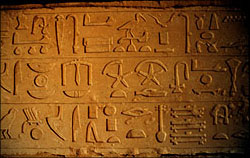Lesson
65 Essay
In
1270, a man named William Wallace was born. He was born in Scotland
and was a landowner. Not much is known about this man's early life. During
William's childhood, Scotland was ruled by Alexander III, who ruled
with stability and kindness. When he died, his granddaughter reigned
for awhile, but after her death she left no clear heir. Several great
families tried to lay claim to the throne. The Scottish government
stepped in and suggested that Edward I of England be king. However,
the people of Scotland wanted
John Balliol as their king.
Edward
pressured John to abdicate his throne and John did just that. Now
Edward was king of Scotland, as well as England. However, most of the
Scots still saw John as their true king and did not want to be
governed by England.
William
Wallace started gathering an army to fight against the English.
Wallace burned the town of Lanmark, killing the English sheriff in
the city. He was less than thirty years old when he marched his army
to defeat the strongholds on the English barrier.
Some
time after this, an English army met William's army near Stirling and
the Fourth River. Even though Wallace was outnumbered, he managed to
gain the upper hand due to his cunning strategies. The Battle of
Stirling Bridge, and subsequently Stirling Castle, were both won by
this little band of Scots.
William
Wallace was knighted and declared the guardian of the kingdom for
these incredible victories. Only four months after the battle at
Stirling, Edward himself invaded Scotland for a second time. The
Scots responded to this invasion by trying to follow the English army
and to attack them at their weaker points. This turned sour as the
Edward's army pounced on the chance to engage the Scots and turned
his army to face them. Edward defeated the Scots and was crowned king
in 1304.
Wallace
somehow escaped and lived as a refugee. Sadly, in 1305, Wallace was
betrayed by a Scottish knight who was loyal to Edward. William was
tried in Westminster Hall and convicted of treason to the crown. He
was executed in a terribly painful way and parts of his body were
displayed as warnings around Scotland.
William
Wallace didn't free Scotland from English rule during his time on
Earth, but he was seen as a martyr and hero to his people to fight
for their freedom. He kept their hope and will to fight alive, and
the Scots finally earned their freedom within 50 years after William
Wallace's death.



